Drift Delicately Keeps to its Title Promise
Frame Dance Productions at Asia Society
by Nancy Wozny
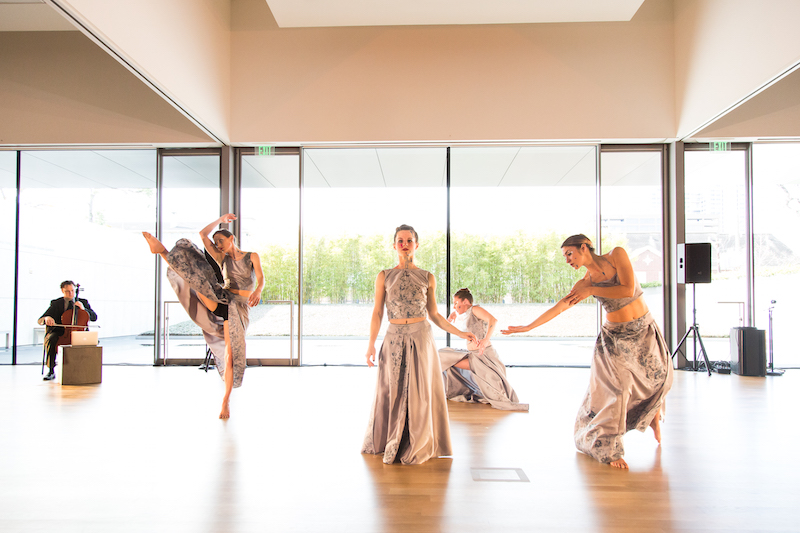
Photo by Lynn Lane
When something is happening, acting on you, but you have yet to notice, that is a particular phenomenon in human experience, which like many things, is magnified on a performing arts stage. That exact experience occurred while watching the opening passages of Lydia Hance’s Drift, presented by Asia Society Texas Center and Frame Dance Productions, Jan. 28-30, 2016, in the spacious expanse of the Edward Rudge Allen III Education Center.
Drift is also the name of a collection of three works, two dance pieces and one music, all of which featured live and original music by Robert McClure, an assistant professor of composition at the School of Music at Soochow University in Suzhou, China. Hance, committed to commissioning original music, often played live, comes at her work with clear ideas that are always presented in a polished format, and Drift was just that.
The Asia Society is certainly the most formal space this troupe has occupied. For a choreographer who is as comfortable having her dancers frolic on the Metro and invade the lobby of the Pennzoil Building, Drift is quite a departure. The last time that I saw the company in action was in front of Lenny’s Sub Shop in the downtown tunnels as part of Hance’s Tunnel Visions. She is well equipped to address an array of spaces, including Yoshio Taniguchi’s elegant interior spaces at the Asia Society.
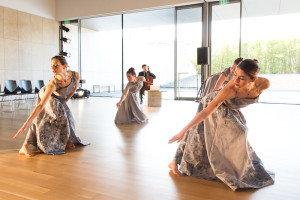
Photo by Lynn Lane
Now, back to the evening’s title piece, Drift. Staring straight out into the Chao Foundation Green Garden, I found myself transfixed by the green lights illuminating the row of bamboo, a perfect backdrop to McClure’s minimalist soundscape, expertly played by members of the Axiom Quartet, Dominika Dancewicz, Ingrid Hunter, Meredith Harris and Patrick Moore. So potent was the spell that I missed Jacquelyne Jay Boe, in what looked like a green heavy brocade ball gown, slowly making her way down the side path, truly drifting into my consciousness. In time, dancers Danielle Garza, Kelsey Jean Gibbs and Catalina Alexandra followed in a floating procession. Watching through the floor-to-ceiling glass windows added a meditative feeling, as if they were carrying out some ancient ritual.
With the music inside and the dance outside, a eerie tension surfaced between inner and outer forces. These outdoor passages proved the most ravishing of the evening. The separation of sound and movement, the glow of the rich green-lit bamboo, the empty space between the musicians beckoning—all of that leading to a kind of quiet drama of anticipation. What are they doing? Why are they so silent? Will they enter the interior space?
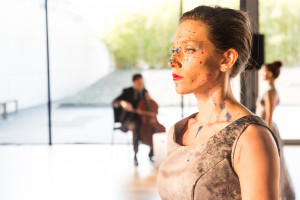
Photo by Lynn Lane
Finally they did, one by one, in a ritualistic procession. At that point, the dance took on a more visceral and energetic tone, with several whirlwind passages of large space devouring movement. It lost some of its mystique as it gained energy. It was almost as if the dance returned to earth, became more flesh and bone, as it moved closer to us. I don’t know if the idea of from far to close was part of the overall plan, but it happened, and that part of it worked well.
Those green stiff dresses transformed into swirling speckled gray silk skirts and tops, matching their glittered eyes and paint-spattered faces, which looked better up close than far away. I was reminded of the surface of the ceramics just downstairs as part of the exhibit, Yeesookyung: Contemporary Korean Sculpture, running through March, 17 2016. Drift’s shape-shifting costumes were designed by Ashley Horn Nott, while Tiffany Schrepferman created the spectacular atmospheric lighting.
Drift is Hance and McClure’s experiment with the I Ching (Book of Changes), a method famously enlisted by John Cage and Merce Cunningham. McClure used a software program by Drake Anderson to accomplish his part. Although the chance elements were not so evident to the audience, I wonder if that even mattered. I appreciate that the team took it on themselves to reinterpret the I Ching toward their own artistic goals.
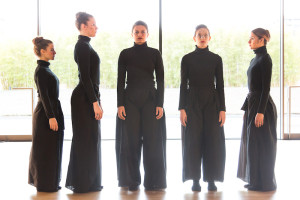
Photo by Lynn Lane
The concert opened with Hance’s Lingering Garden, an even more meditative piece set to McClure’s score culled from recorded sounds from Lingering Garden in Suzhou, China. Hance’s restraint was in fuller evidence in this work, as it begins in total darkness. Yes, another piece that begins before it begins. The dancers shuffle in, making a wonderful whisking sound, created in part by Nott’s stiff black skirt-like pants. Slightly robotic and totally driven, the dancers seem to be carrying out a set of instructions, following a map of sorts, completing a mission. Again we wonder, what’s going on? Hance builds up considerable tension before she lets her able dancers do anything else than shuffle about the room in complex patterns. And even then, she starts cautiously, with a simple raise of the shoulders, as if to pause from all that traveling.
The middle of the show featured McClure’s at water’s edge, played with precision and intensity by Ling Ling Huang and Luke Hubley and crafted from a life observed in Suzhou, where he resides, McClure’s at water’s edge, like the two pieces it anchored, also dwelled in the tension of space, creating a sonic landscape that took us far from home.
Nancy Wozny is editor in chief of Arts + Culture Texas, reviews editor at Dance Source Houston, a contributing editor at Dance Magazine and a scholar in residence at Jacob’s Pillow Dance since 2010.
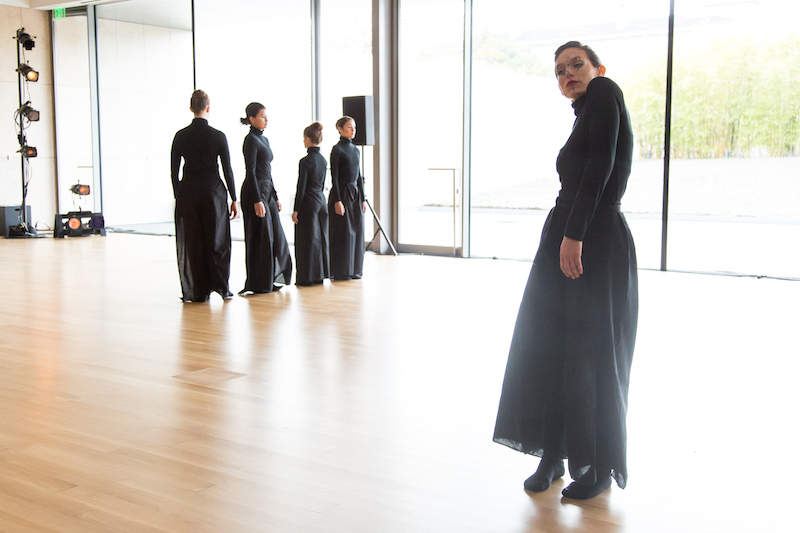
Photo by Lynn Lane



Recent Comments